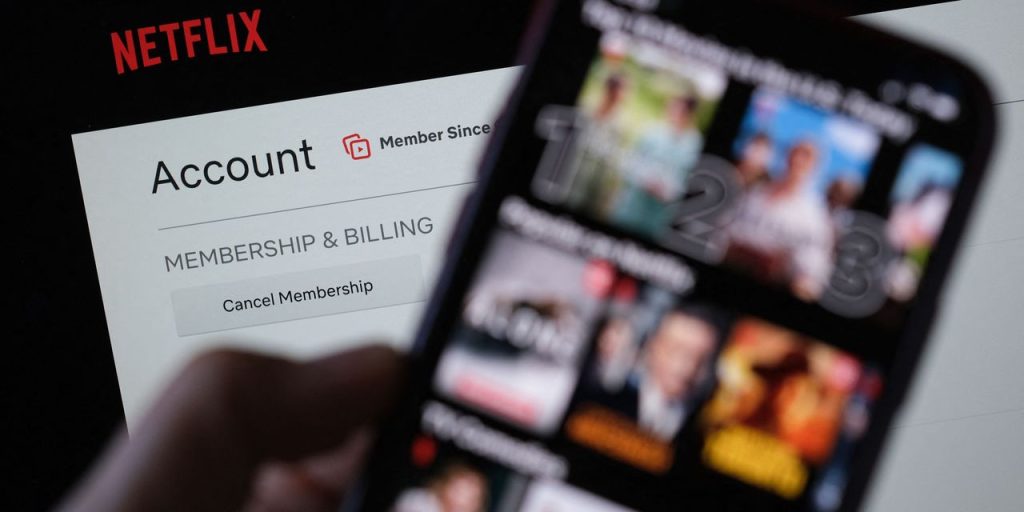Netflix Inc. announced another price increase for its streaming service Wednesday, which made its cheaper, advertising-based offering look like an even better deal — and that is the point.
Netflix
NFLX,
executives revealed Wednesday evening that the “basic” plan, the cheapest Netflix streaming offering without commercials, will now cost $11.99 a month, up from $9.99 a month. That plan doesn’t even exist for most potential subscribers, however: Netflix is no longer offering it to new and returning subscribers in the U.S., U.K., Italy and Canada, and other countries that offer advertising-supported offerings, and Germany, Spain, Japan, Mexico, Australia and Brazil will soon follow.
The reason: Netflix would rather push cost-conscious consumers toward its $6.99-a-month plan that includes advertisements, which launched last year. The reason is rather simple: To entice advertisers and make substantial money from that business, Netflix needs as many subscribers as it can get watching those commercials.
Executives basically admitted their approach in a letter to shareholders detailing quarterly earnings Wednesday, writing: “Our immediate priority is building our ad membership so that Netflix becomes an essential buy for advertisers, which is key for advertising to become material to our business.”
Also see: After Netflix’s price hike, here’s how much the major streaming services will cost
Brandon Katz, an entertainment industry analyst for Parrot Analytics, called it “basic pricing-power strategy at play.”
“They are increasing prices for different plans in order to essentially move people either to their more expensive standard and premium plans, or to the ad-supported tier,” he told MarketWatch in an interview. “Now, the reason why they want to do that is, if they get people to pay more for the standard and premium tier, that increases their average revenue per user, that makes them more money. If they push people to the cheaper, ad-supported tier because of the ad dollars coming in, that also has a higher average revenue per user than their basic plan, so that again makes them more money.”
As Netflix makes these changes, the ad-supported offering increasingly looks like the best deal for consumers. New subscribers in the U.S. today are able to choose between two tiers of service without commercials — $15.49 a month for the “standard” plan that offers basically the same level of service as the ad-supported tier, as well as a “premium” plan that costs $22.99 a month, a $3 increase from previous pricing — or pay $6.99 a month with ads.
Also see: Netflix turning password sharing clampdown into paid sharing boost, say analysts
The ad-supported price is likely to stay low for a while, as Netflix plays the same game that made it a streaming giant. For many years, Netflix attracted subscribers with low prices as it pushed out original content and hooked them on the service, but it has steadily raised prices in recent years as subscription gains have slowed down. Netflix executives will now be expected to keep the ad-supported price low until that price pushes the subscriber base to the level the company needs to obtain the advertising rates and revenue that executives desire.
“I expect that [ad-supported] price to probably stay there until they reach a first benchmark, critical-mass subscriber plateau,” Katz said, though that could take a long time.
While Netflix is essentially charging new subscribers an additional $9.50 a month to not see commercials, executives are potentially eyeing more revenue from ad-tier subscribers than those paying for the “standard” plan, after adding in the revenue that ads deliver.
“We estimate that an ad-supported model could generate $10 per month per subscriber in ad revenues, or higher over time, based on comparable rates generated (on a per-hour basis) by fuboTV
FUBO,
the Roku
ROKU,
Channel and Hulu,” Wedbush analysts wrote in a note earlier this month, while reporting that Netflix was likely currently making around $8 a month on ad-supported subscribers, based on second-quarter results.
With its pricing power and the many levers that executives are pulling right now to increase the amount of revenue they pull in for every subscriber, Wall Street seems to be falling back in love with Netflix after the stock has suffered in recent years. Shares jumped 16.1% on Thursday, their best day in more than two years, after the company detailed third-quarter earnings and the subscription-price increases.
Read the full article here




